Double-Recycled Reclaimed Asphalt Pavement: A Laboratory Investigation at Low Temperatures Based on Different Mathematical Approaches
Abstract
1. Introduction
2. Objective and Research Approach
3. Material Preparation
4. Experimental Work
- S(t) = time-dependent flexural creep stiffness (MPa);
- D(t) = creep compliance (1/MPa);
- σ = bending stress in the beam (MPa);
- ε(t) = time-dependent bending strain in the beam (mm/mm);
- P = applied constant load (mN);
- δ(t) = beam deflection (mm);
- L, b, h = beam dimensions (L = 102 mm, b = 12.7 mm, h = 6.25 mm);
- t = time (s);
- A1, A2, A3 = fitting constants
5. Mathematical Approaches for Computing Thermal Stress and Critical Cracking Temperature
5.1. Simple Power Law Model (Method 1)
- tc, ν and w = fitting parameters;
- aT = shift factor; this can be expressed as:
- C1, C2 = constant parameters, and
- Ts = reference temperature (°C, lowPG + 10 °C).
5.2. Hopkins and Hamming’s Algorithm (Method 2)
5.3. Laplace Transformation (Method 3)
- (1)
- (2)
- Rewrite Equation (17) as follows:
- (3)
- Generate master curve of D(ξ) in the reduced time domain using D(t) experimental data based on dual series of power law function as seen in Equation (19).where:A, B, C and D are fitting parameters.In this study, the average value of D(ξ) (i.e., average between D(ξ, at lowPG + 10 °C) and D(ξ, at lowPG + 10 − 12 °C) data were considered.
- (4)
- Consider Equations (17)–(19) to relate thermal stress and strain assuming an idealized scheme as:
- (5)
- With considerations of the Laplace transformation, Equation (20) can be expressed as:Based on Equations (17)–(21) parameter α and T can be reexpressed as:
- (6)
- (7)
- Compute thermal stress, (T) in the actual time domain, starting from the thermal stress: σ(ξ) in the reduced time domain using Equations (17)–(24).
6. Data Analysis
6.1. Creep Stiffness and m-Value
6.2. Thermal Stress
6.2.1. Thermal Stress Curves
6.2.2. Thermal Stress Factor (TSF)
6.3. Comparisons on Critical Cracking Temperature
7. Summary and Conclusions
- BBR mixture creep results indicate that mixtures prepared with SRRAP have almost identical low-temperature cracking performance to that of mixtures designed with DRRAP. As expected, all RAP mixtures (SRRAP or DRRAP) presented a poorer performance at low temperatures compared to the conventional asphalt mixtures;
- By applying different mathematical approaches, upper and lower bounds on thermal stress can be derived. In the case of critical cracking temperature, the different mathematical approaches did not provide clear upper and lower bounds. In this sense, the use of strength or fracture tests is recommended to verify if the three different formulations may result in a consistent critical cracking temperature;
- The TSF values support the trends obtained from the experimentation and provide a simple tool that could be potentially used on a routine basis from practitioners to compare the response of mixtures against low-temperature cracking. In this view, the three mathematical models provide the link between the experimental measurements and the practical information obtained from the TSF.
Author Contributions
Funding
Acknowledgments
Conflicts of Interest
References
- Behnnood, A. Application of rejuvenators to improve the rheological and mechanical properties of asphalt binders and mixtures: A review. J. Clean. Prod. 2019, 230, 171–182. [Google Scholar] [CrossRef]
- Alsalihi, M.; Faheem, A. Compaction and performance of warm mix asphalt with high reclaimed asphalt pavement. American Soc. Civ. Eng. J. Mater. Civ. Eng. 2020, 32, 117015. [Google Scholar] [CrossRef]
- Lakshmi Roja, K.; Masad, E.; Mogawar, W. Performance and blending evaluation of asphalt mixtures containing reclaimed asphalt pavement. Road Mater. Pavement Des. 2020, 1–17. [Google Scholar] [CrossRef]
- Ziari, H.; Aliha MR, M.; Moniri, A.; Saghafi, Y. Crack resistance of hot mix asphalt containing different percentages of reclaimed asphalt pavement and glass fiber. Constr. Build. Mater. 2020, 230, 117015. [Google Scholar] [CrossRef]
- Zhu, J.; Ma, T.; Fan, J.; Fang, Z.; Chen, T.; Zhou, Y. Experimental study of high modulus asphalt mixture containing reclimed asphalt ovement. J. Clean. Prod. 2020, 263, 121447. [Google Scholar] [CrossRef]
- Moon, K.H.; Cannone Falchetto, A.; Marasteanu, M.; Turos, M. Using recycled asphalt materials as an alternative material source in asphalt pavements. KSCE J. Civ. Eng. 2014, 18, 149–159. [Google Scholar] [CrossRef]
- Moon, K.H.; Cannone Falchetto, A.; Marasteanu, M.; Wistuba, P. Low temperature rheological properties of asphalt mixtures containing different recycled asphalt materials. Int. J. Pavement Res. Technol. 2017, 10, 84–97. [Google Scholar] [CrossRef]
- Poulikakos, L.D.; Papadaskalopoulou, C.; Hofko, B.; Gschosser, F.; Cannone Falchetto, A.; Bueno, M.; Arraigada, M.; Sousa, R.; Ruiz, R.; Pettit, C.; et al. Harvesting the unexplored potential of European waste materials for road construction. Resour. Conserv. Recycl. 2017, 116, 32–44. [Google Scholar] [CrossRef]
- Medina, C.; Zhu, W.; Howind, T.; Frias, M.; De Rojas, S. Effect of the constituents (asphalt, clay materials, floating particles and fines) of construction and demolition waste on the properties of recycled concretes. Constr. Build. Mater. 2015, 79, 22–33. [Google Scholar] [CrossRef]
- Ossa, A.; Garcia, J.L.; Votero, E. Use of recycled construction and demolition waste (CDW) aggregates: A sustainable alternative for the pavement construction industry. J. Clean. Prod. 2016, 135, 379–386. [Google Scholar] [CrossRef]
- Barisic, I.; Grubesa, I.N.; Kutuzovic, B.H. Multidisciplinary approach to the environmental impact of steel slag reused in road construction. Road Mater. Pavement Des. 2017, 18, 897–912. [Google Scholar] [CrossRef]
- Cannone Falchetto, A.; Moon, K.H.; Wang, D.; Riccardi, C.; Kang, M.S.; Wistuba, M.P. Investigation on the combined recycling of reclaimed asphalt pavement and steel slag in asphalt mixture at low temperature. In Proceedings of the 5th International Conference on Sustainable Solid Waste Management, Athens, Greece, 21–24 June 2017; Volume 13, pp. 75–80. [Google Scholar]
- Groenniger, J.; Cannone Falchetto, A.; Isailovic, I.; Wang, D.; Wistuba, M.P. Experimental investigation of asphalt mixture containing Linz-Donawitz steel slag. J. Traffic Transp. Eng. 2017, 4, 372–379. [Google Scholar] [CrossRef]
- Cannone Falchetto, A.; Monetepara, A.; Tebaldi, G.; Marasteanu, M.O. Microstructural and rheological investigation on the use of recycled asphalt material in asphalt mixtures at low temperature. Constr. Build. Mater. 2012, 35, 321–329. [Google Scholar] [CrossRef]
- Bressi, S.; Cavalli, M.C.; Partl, M.N.; Tebaldi, G.; Dumont, A.G.; Poulikakos, L.D. Particle clustering phenomena in hot asphalt mixtures with high content of reclaimed asphalt pavements. Constr. Build. Mater. 2015, 100, 207–217. [Google Scholar] [CrossRef]
- Moon, K.H.; Cannone Falchetto, A.; Marasteanu, M.O. Performance of reclaimed asphalt pavement mixtures under static and oscillatory loading. Proc. Inst. Civ. Eng. Transp. 2013, 168, 71–82. [Google Scholar] [CrossRef]
- EAPA. Available online: http://eapa.org/wp-content/uploads/2019/08/Asphalt-in-figures_2017.pdf (accessed on 1 May 2020).
- The Guidance on Promoting Pavement Material Recycling; Ministry of Transport: Beijing, China, 2012; p. 489, No. 489.
- Moon, K.H.; Cannone Falchetto, A.; Jeong, J.H. Microstructural analysis of asphalt mixtures using digital image processing techniques. Can. J. Civ. Eng. 2013, 41, 74–86. [Google Scholar] [CrossRef]
- Jeon, J.H.; Hwang, S.D.; Mun, S.H. Performance evaluation of recycled hot mixed asphalt mixture with reclaimed aggregate ratio (Korean). Korean Soc. Road Eng. 2019, 21, 9–17. [Google Scholar] [CrossRef]
- Kim, D.H.; Lee, J.M.; Moon, K.H.; Park, J.S.; Suh, Y.C.; Jeong, J.H. Development of remodeling index model to predict priority of large-scale repair works of deteriorated expressway concrete pavements in Korea. KSCE J. Civ. Eng. 2019, 23, 2096–2107. [Google Scholar] [CrossRef]
- Lee, J.H.; Baek, S.B.; Lee, K.H.; Kim, J.S.; Jeong, J.H. Long-term performance of fiber-grid-reinforced asphalt overlay pavements: A case study of Korean national highways. J. Traffic Transp. Eng. Engl. Ed. 2019, 6, 366–382. [Google Scholar] [CrossRef]
- Yoshikane, T. Investigation of Deterioration of Recycled Hot-Mixed Asphalt Concrete Pavement and a Trial re-Recycling of Asphalt Concrete. In Disposal and Recycling of Organic and Polymeric Construction Materials: Proceedings of the International RILEM Workshop; CRC Press: Boca Raton, FL, USA, 1995; pp. 218–229. [Google Scholar]
- Su, K.; Hachity, Y.; Maekawa, R. Laboratory investigation of possibility of re-recycling asphalt concretes. In Proceedings of the 6th International Conference on Pavement Technologies, Yokosuka, Japan, July 2008; pp. 435–442. [Google Scholar]
- Heneash, U. Effect of the Repeated Recycling on Hot Mix Asphalt Properties. Ph.D. Thesis, University of Nottingham, Nottingham, UK, 2013. [Google Scholar]
- Idham, M.K.; Hainin, M.R. The effect of incorporating reclaimed asphalt pavement on the performance of hot mix asphalt mixtures. J. Teknol. 2015, 77, 117–123. [Google Scholar] [CrossRef]
- Hugener, M.; Kawakami, A. Simulating repeated recycling of hot mix asphalt. Road Mater. Pavement Des. 2017, 18, 76–90. [Google Scholar] [CrossRef]
- Kareem, A.I.; Nikraz, H.; Asadi, H. Performance of hot-mix asphalt produced with double coated recycled concrete aggregates. Constr. Build. Mater. 2019, 205, 425–433. [Google Scholar] [CrossRef]
- Kareem, A.I.; Nikraz, H.; Asadi, H. Application of Double-Coated Recycled Concrete Aggregates for Hot-Mix Asphalt. ASCE-J. Mater. Civ. Eng. 2019, 31. [Google Scholar] [CrossRef]
- Marasteanu, M.O.; Velasquez, R.A.; Cannone Falchetto, A.; Zofka, A. Development of a Simple Test to Determine the Low Temperature Creep Compliance of Asphalt Mixtures; NCHRP-133 Final Report, National Cooperative Highway Research Program; Transportation Research Board: Washington, DC, USA, 2009. [Google Scholar]
- Moon, K.H. Comparison of Thermal Stresses Calculated from Asphalt Binder and Asphalt Mixture Creep Compliance Data. M.S. Thesis, University of Minnesota, Minneapolis, MN, USA, 2009. [Google Scholar]
- Moon, K.H.; Marasteanu, M.O.; Turos, M. Comparison of thermal stresses calculated from asphalt binder and asphalt mixture creep tests. ASCE-J. Mater. Civ. Eng. 2013, 25, 1059–1067. [Google Scholar] [CrossRef]
- Cannone Falchetto, A.; Marasteanu, M.O. Physical hardening: From binders to mixtures. Int. J. Roads Airports 2011, 1, 18–34. [Google Scholar] [CrossRef]
- AASHTO. Standard Specification for Performance-Graded Asphalt Binder; Specification: M320-16; American Association of State Highway and Transportation Officials: Washington, DC, USA, 2016. [Google Scholar]
- MOLIT. A Specification for Production, Management and Construction of Hot Mix Asphalt Material; Ministry of Land, Infrastructure and Transport-South Korea: Seoul, Korea, 2017. [Google Scholar]
- AASHTO. Determining the Flexural Creep Stiffness of Asphalt Binder Using the Bending Beam Rheometer (BBR); Specification T 313-12; American Association of State Highway and Transportation Officials: Washington, DC, USA, 2012. [Google Scholar]
- Hopkins, I.L.; Hamming, R.W. On creep and relaxation. J. Appl. Phys. 1957, 28, 906–909. [Google Scholar] [CrossRef]
- Ebrahimi, M.G.; Saleh, M.; Gonzalez, M.A.M. Interconversion between viscoelastic functions using the Tikhonov regularization method and its comparison with approximate techniques. Road Mater. Pavement Des. 2014, 15, 820–840. [Google Scholar] [CrossRef]
- Ferry, J.D. Viscoelastic Properties of Polymers, 3rd ed.; Wiley: New York, NY, USA, 1980. [Google Scholar]
- Findley, W.N.; Lai, J.S.; Onaran, K. Creep and Relaxation of Nonlinear Viscoelastic Materials; Dover Publications: New York, NY, USA, 1976. [Google Scholar]
- Park, S.W.; Kim, Y.R. Interconversion between relaxation modulus and creep compliance for viscoelastic solids. ASCE-J. Mater. Civ. Eng. 1999, 11, 76–82. [Google Scholar] [CrossRef]
- Moon, K.H.; Kwon, O.S.; Cho, M.J.; Cannone Falchetto, A. An alternative one-step computation approach for computing thermal stress of asphalt mixture: The Laplace Transformation. KSCE J. Civ. Eng. 2019, 39, 219–225. [Google Scholar] [CrossRef]
- Shenoy, A. Single event cracking temperature of asphalt pavements directly from the Bending Beam Rheometer (BBR) beam data. ASCE-J. Transp. Eng. 2002, 128, 465–471. [Google Scholar] [CrossRef]
- Stehfest, H. Algorithm 368: Numerical inversion of Laplace transform. Commun. Assoc. Comput. Mach. 1970, 13, 47–49. [Google Scholar] [CrossRef]
- Villinger, H. Solving cylindrical geothermal problems using Gaver-Stehfest inverse Laplace transform. Geophysics 1985, 50, 1581–1587. [Google Scholar] [CrossRef]
- Poulikakos, L.D.; Cannone Falchetto, A.; Wang, D.; Porot, L.; Hofko, B. Impact of asphalt aging temperature on chemomechanics. RSC Adv. 2019, 9, 11602. [Google Scholar] [CrossRef]


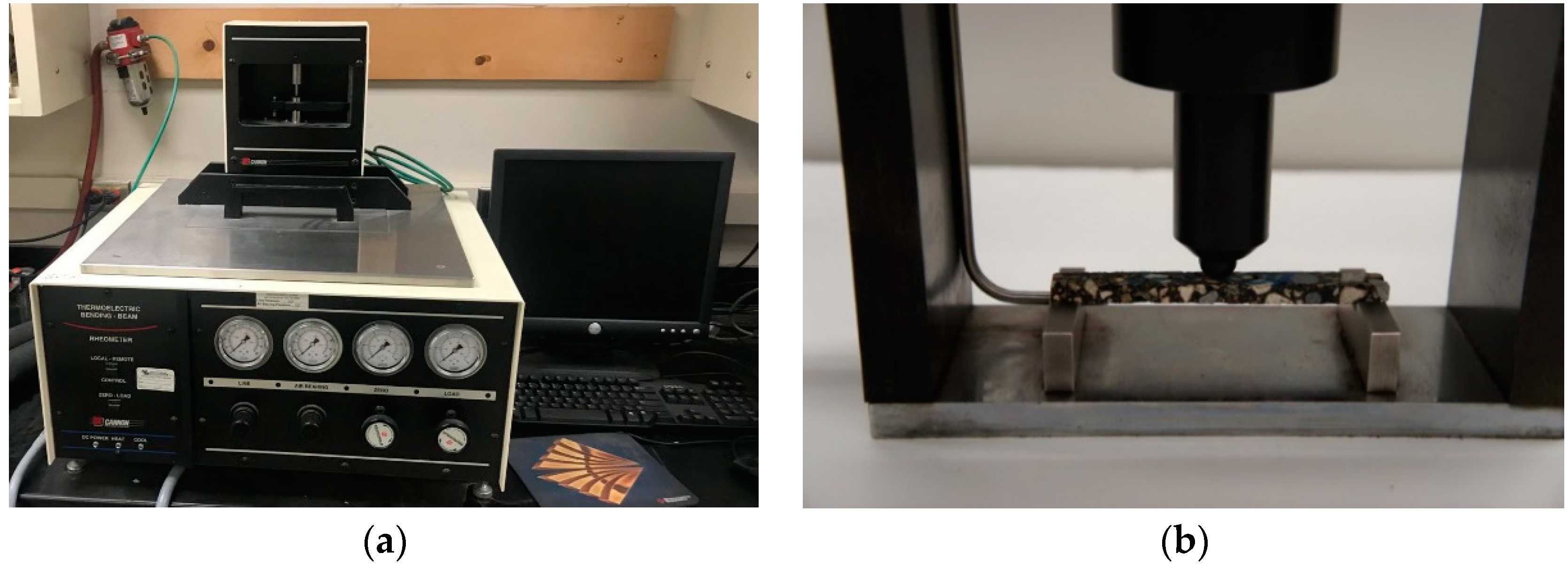
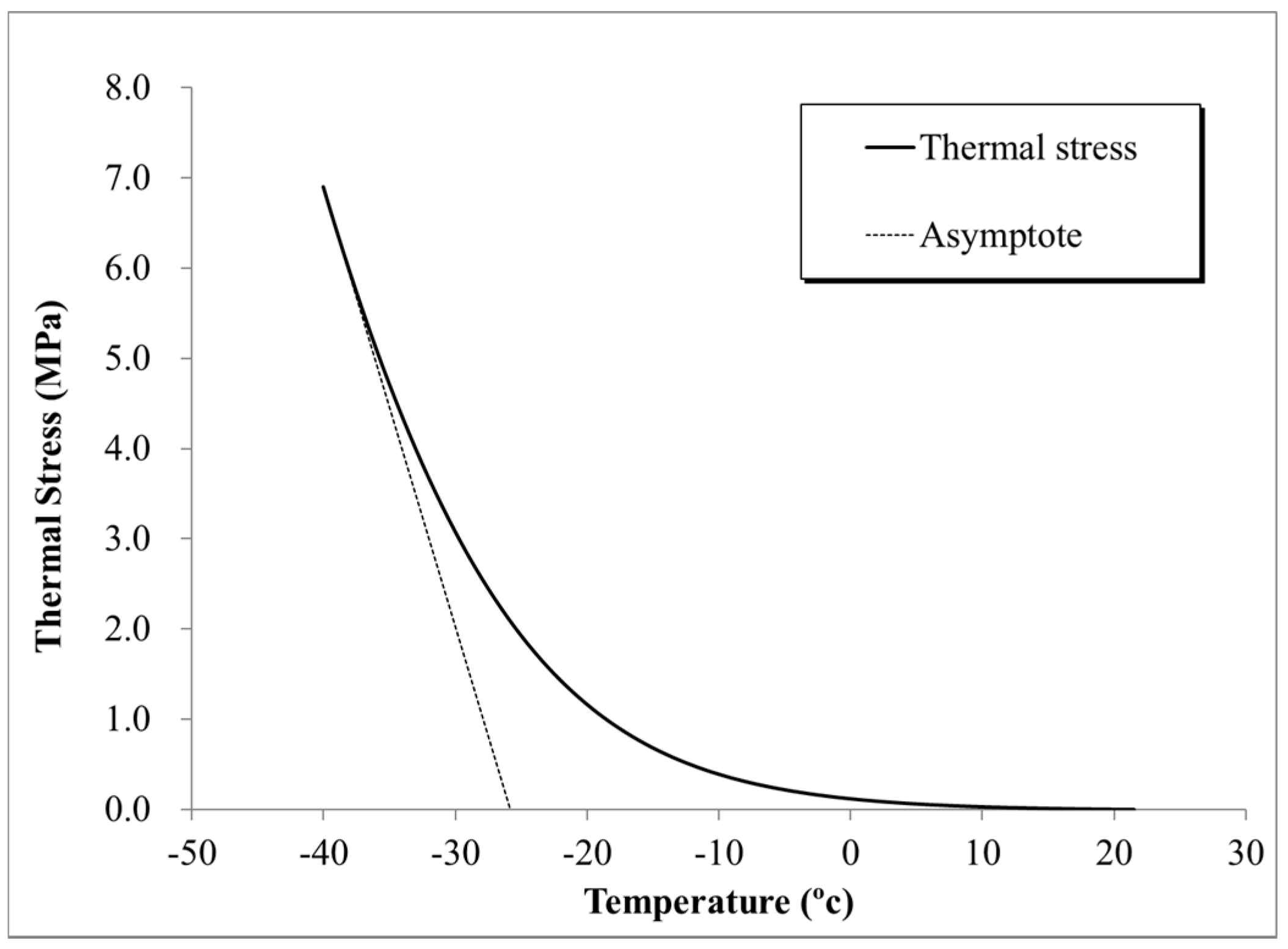
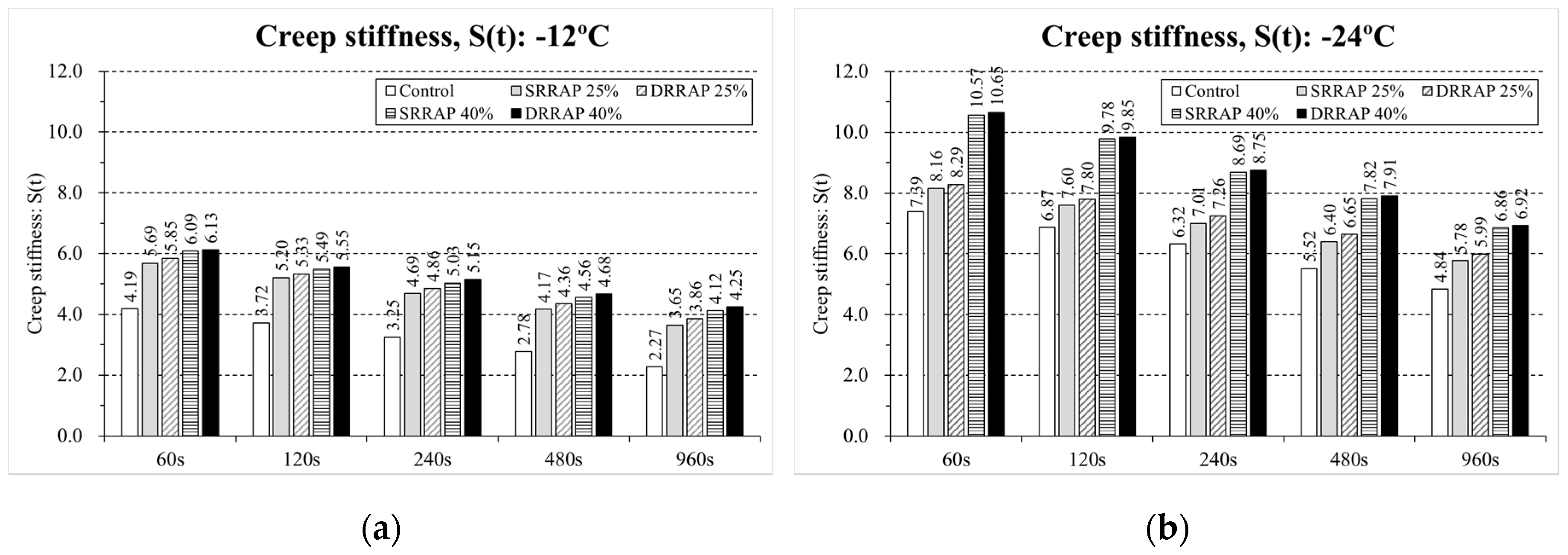
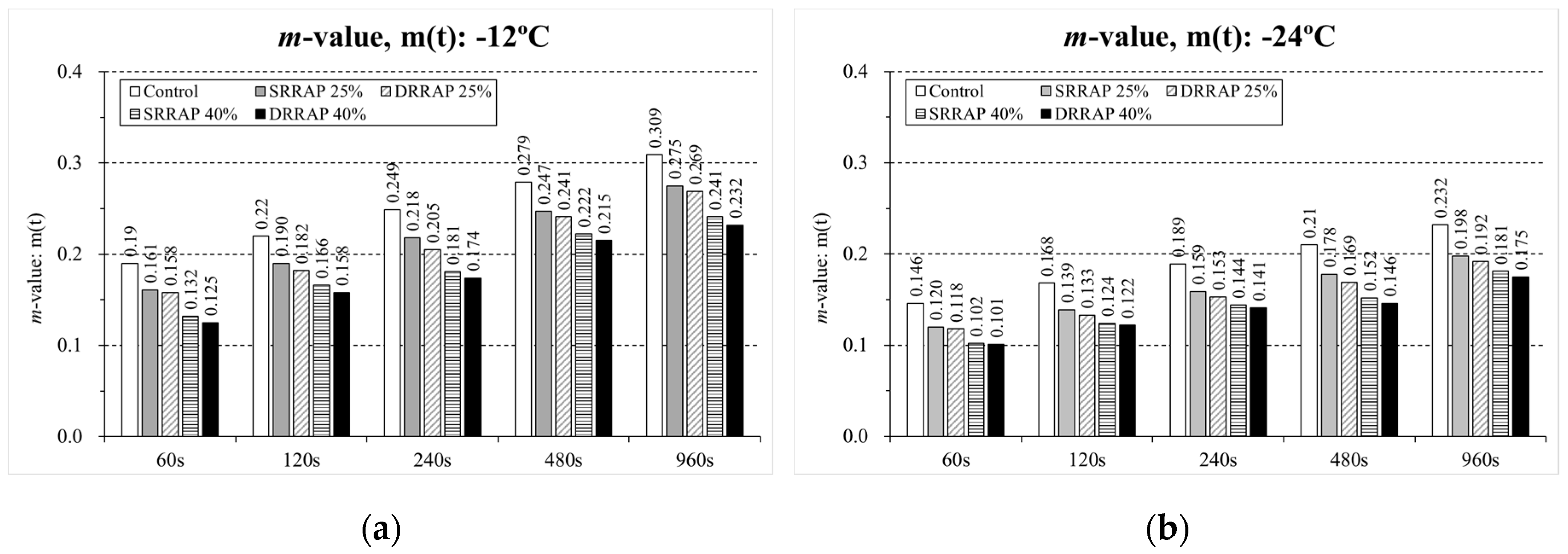
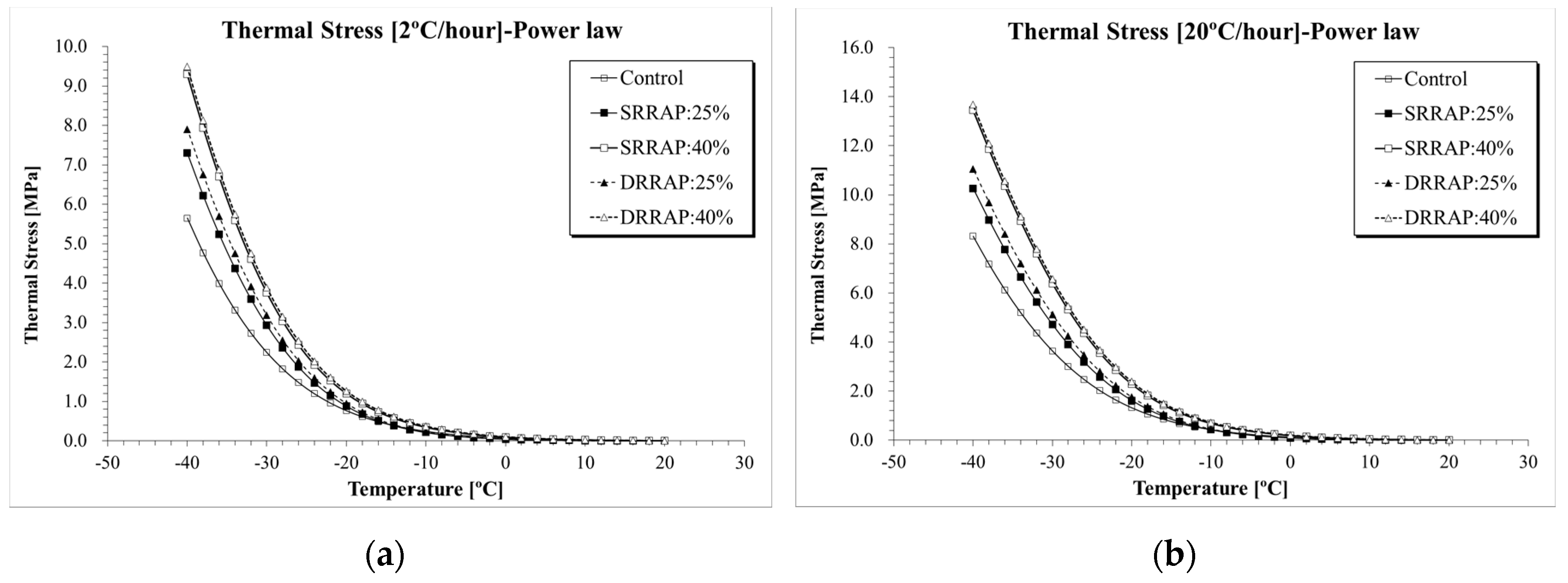

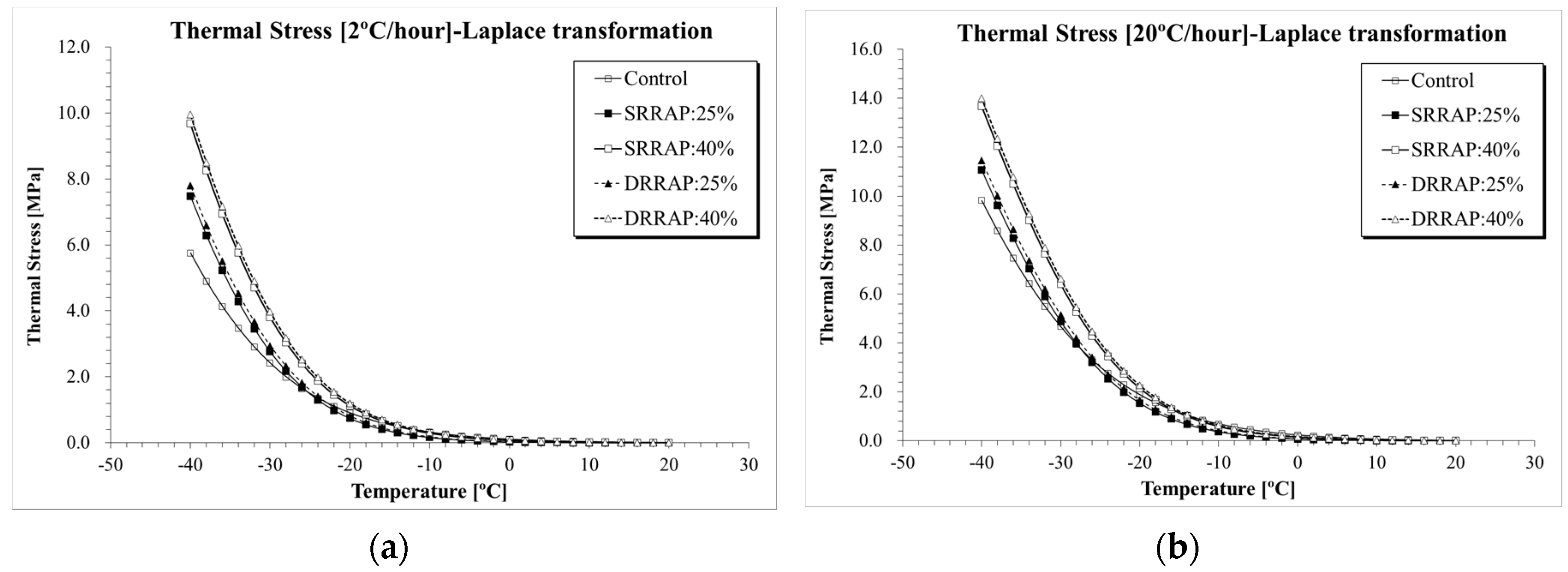


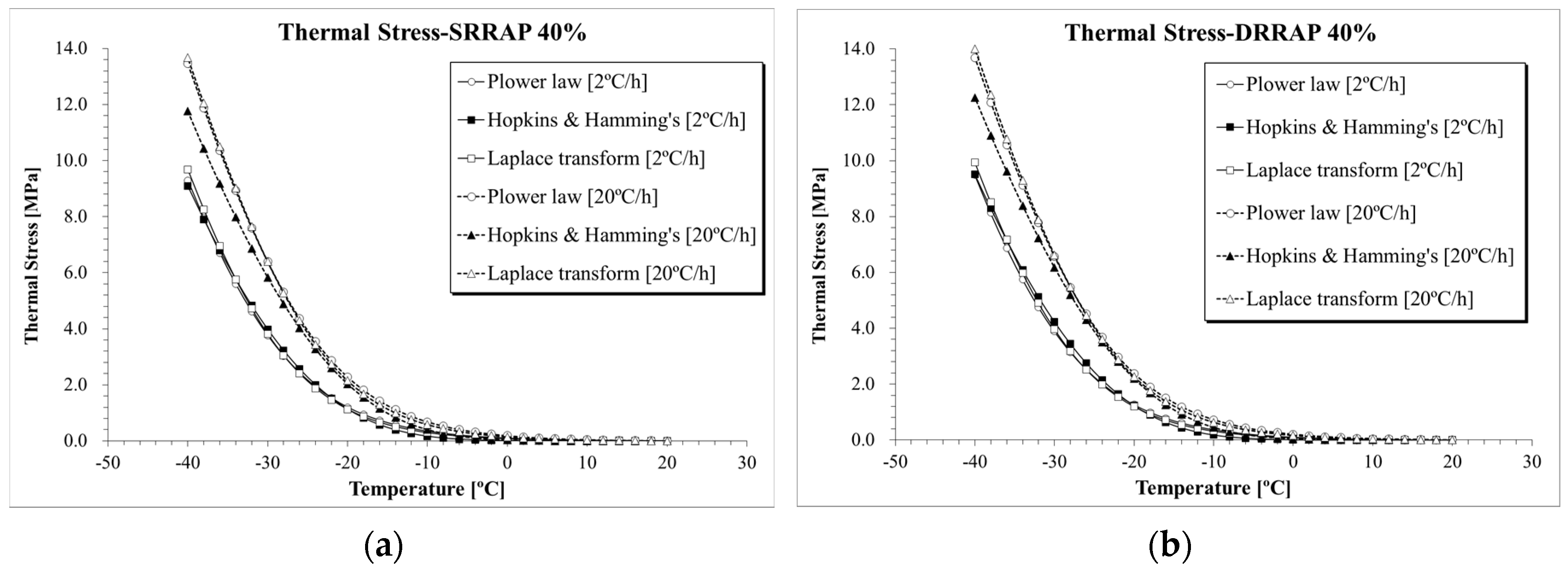
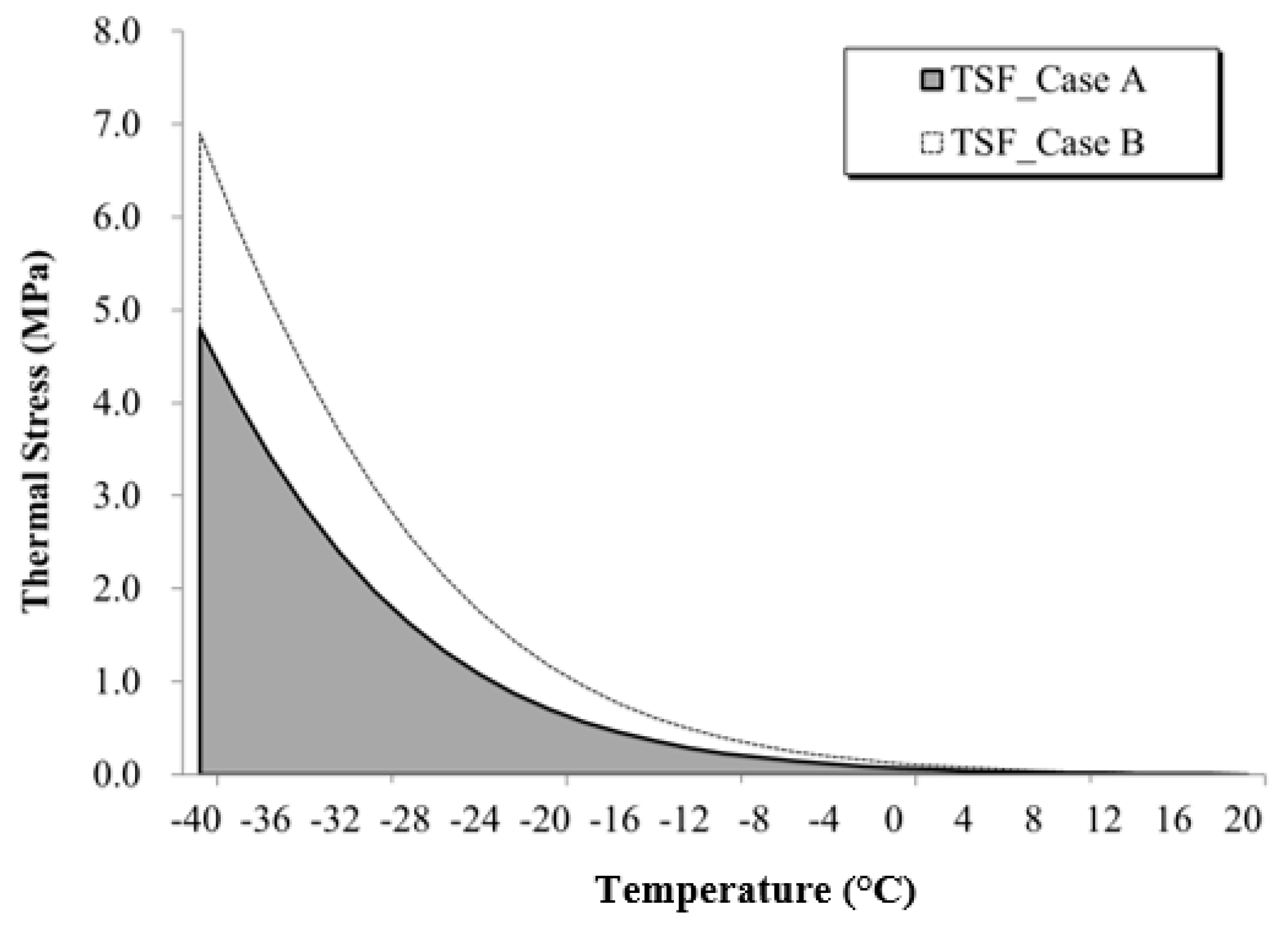
| Mix ID | Recycling Level | Asphalt Binder (PG) | RAP (%) | RAP Origin Mixture | NMAS (mm) | Aggregate Gradation Size (mm)/Passing (%) | Target Air Voids (%) |
|---|---|---|---|---|---|---|---|
| A | Reference (virgin) | 64–22 | 0 | – | 12.5 | (13/91), (10/82), (5/60), (2.5/41), (0.6/22), (0.3/16), (0.15/10), (0.08/6) | 4.2–4.9 |
| B | SRRAP 1 | 64–22 | 25 | A | 12.5 | (13/92), (10/78), (5/55), (2.5/35), (0.6/20), (0.3/15), (0.15/11), (0.08/5) | 4.2–4.9 |
| C | SRRAP | 64–22 | 40 | A | 12.5 | (13/91), (10/77), (5/54), (2.5/37), (0.6/22), (0.3/17), (0.15/12), (0.08/6) | 4.2–4.9 |
| D | DRRAP 2 | 64–22 | 25 | B | 12.5 | (13/92), (10/79), (5/53), (2.5/35), (0.6/23), (0.3/16), (0.15/11), (0.08/5) | 4.2–4.9 |
| E | DRRAP | 64–22 | 40 | C | 12.5 | (13/91), (10/81), (5/50), (2.5/34), (0.6/24), (0.3/15), (0.15/11), (0.08/5) | 4.2–4.9 |
| Test | Mix ID | Asphalt Binder PG | Testing Temperature (°C) (Number of Replicates) | Applied Load (mN) (Testing Temperature °C) |
|---|---|---|---|---|
| BBR | A, B, C, D, E | PG 64–22 | low(PG + 10 °C) = −12 °C (10) low(PG + 10 °C) – 12 °C = −24 °C (10) | 4000-mN (−12 °C) 6000-mN (−24 °C) |
| Mix ID | RAP (%) | Creep Stiffness: S(t) (GPa), Coefficient of Variation, (%) | |||||||||
|---|---|---|---|---|---|---|---|---|---|---|---|
| 60 s | 120 s | 240 s | 480 s | 960 s | |||||||
| −12 °C | −24 °C | −12 °C | −24 °C | −12 °C | −24 °C | −12 °C | −24 °C | −12 °C | −24 °C | ||
| A | Control (0%) | 4.19 (9.4%) | 7.39 (10.2%) | 3.72 (8.8%) | 6.87 (8.2%) | 3.25 (9.6%) | 6.32 (9.5%) | 2.78 (9.4%) | 5.52 (10.1%) | 2.27 (7.6%) | 4.84 (7.2%) |
| B | SRRAP (25%) | 5.69 (8.2%) | 8.16 (9.5%) | 5.20 (9.8%) | 7.60 (10.1%) | 4.69 (8.7%) | 7.07 (8.8%) | 4.17 (10.5%) | 6.40 (9.2%) | 3.65 (9.1%) | 5.78 (8.1%) |
| C | SRRAP (40%) | 6.09 (9.9%) | 10.57 (8.5%) | 5.49 (8.1%) | 9.78 (9.5%) | 5.03 (7.4%) | 8.69 (9.3%) | 4.56 (9.6%) | 7.82 (9.8%) | 4.12 (9.2%) | 6.86 (7.9%) |
| D | DRRAP (25%) | 5.85 (8.5%) | 8.29 (9.2%) | 5.33 (8.4%) | 7.80 (9.5%) | 4.86 (9.1%) | 7.26 (8.8%) | 4.36 (7.8%) | 6.65 (8.4%) | 3.86 (8.3%) | 5.99 (8.7%) |
| E | DRRAP (40%) | 6.13 (9.5%) | 10.65 (8.8%) | 5.55 (9.3%) | 9.85 (9.2%) | 5.15 (8.7%) | 8.75 (9.4%) | 4.68 (8.4%) | 7.91 (9.9%) | 4.25 (8.6%) | 6.92 (8.2%) |
| Mix ID | RAP (%) | m-Value: m(t) = dS(t)/dt, Coefficient of Variation (%) | |||||||||
|---|---|---|---|---|---|---|---|---|---|---|---|
| 60 s | 120 s | 240 s | 480 s | 960 s | |||||||
| −12 °C | −24 °C | −12 °C | −24 °C | −12 °C | −24 °C | −12 °C | −24 °C | −12 °C | −24 °C | ||
| A | Control (0%) | 0.190 (9.7%) | 0.146 (10.6%) | 0.220 (8.5%) | 0.168 (8.7%) | 0.249 (9.7%) | 0.189 (8.5%) | 0.279 (10.0%) | 0.210 (9.5%) | 0.309 (7.9%) | 0.232 (8.6%) |
| B | SRRAP (25%) | 0.161 (9.9%) | 0.120 (9.8%) | 0.190 (9.3%) | 0.139 (9.1%) | 0.218 (9.4%) | 0.159 (8.8%) | 0.247 (10.5%) | 0.178 (9.1%) | 0.275 (7.7%) | 0.198 (9.5%) |
| C | SRRAP (40%) | 0.132 (9.1%) | 0.102 (8.1%) | 0.166 (9.9%) | 0.124 (7.5%) | 0.181 (8.4%) | 0.144 (9.2%) | 0.222 (10.1%) | 0.152 (9.5%) | 0.241 (8.4%) | 0.181 (9.2%) |
| D | DRRAP (25%) | 0.158 (8.4%) | 0.118 (8.6%) | 0.182 (9.4%) | 0.133 (8.4%) | 0.205 (8.1%) | 0.153 (8.4%) | 0.241 (7.1%) | 0.169 (9.5%) | 0.269 (7.4%) | 0.192 (8.5%) |
| E | DRRAP (40%) | 0.125 (8.8%) | 0.101 (8.3%) | 0.158 (9.8%) | 0.122 (8.9%) | 0.174 (9.5%) | 0.141 (8.8%) | 0.215 (8.4%) | 0.146 (9.9%) | 0.232 (8.6%) | 0.175 (9.2%) |
| ID | Mixture | Approach | Area (MPa·°C) | TFS (%) [MixReference] − [MixInterest] | ||
|---|---|---|---|---|---|---|
| 2 °C/h | 20 °C/h | 2 °C/h | 20 °C/h | |||
| A | Control | PL | 58.0 | 92.5 | – – | – – |
| HH | 50.9 | 78.6 | – – | – – | ||
| LA | 62.9 | 115.4 | – – | – – | ||
| B | SRRAP 25% | PL | 72.7 | 114.8 | 25.3 PL: [B] − [A] | 24.1 PL: [B] − [A] |
| HH | 62.5 | 101.6 | 22.8 HH: [B] − [A] | 29.3 HH: [B] − [A] | ||
| LA | 69.5 | 119.4 | 10.5 LA: [B] − [A] | 3.5 LA: [B] − [A] | ||
| D | DRRAP 25% | PL | 78.8 | 124.3 | 8.4 PL: [C] − [B] | 8.3 PL: [C] − [B] |
| HH | 64.7 | 104.6 | 3.5 HH: [C] − [B] | 3.0 HH: [C] − [B] | ||
| LA | 73.9 | 124.6 | 6.3 LA: [3] − [2] | 4.4 LA: [3] − [2] | ||
| C | SRRAP 40% | PL | 95.0 | 156.8 | 63.8 PL: [D] − [A] | 69.5 PL: [D] − [A] |
| HH | 93.3 | 136.4 | 83.3 HH: [D] − [A] | 73.5 HH: [D] − [A] | ||
| LA | 95.6 | 154.9 | 52.0 LA: [D] − [A] | 34.2 LA: [D] − [A] | ||
| E | DRRAP 40% | PL | 98.4 | 161.2 | 3.6 PL: [E] − [D] | 2.8 PL: [E] − [D] |
| HH | 99.2 | 144.2 | 6.3 HH: [E] − [D] | 5.7 HH: [E] − [D] | ||
| LA | 99.7 | 160.5 | 4.3 LA: [E] − [D] | 3.6 LA: [E] − [D] | ||
| Mixture | TCR (°C) | TCR Ranking | ||
|---|---|---|---|---|
| PL | HH | LA | ||
| Control | −27.7 | −27.3 | −27.2 | LA > HH > PL |
| SRRAP 25% | −26.9 | −28.2 | −27.7 | PL > LA > HH |
| SRRAP 40% | −26.6 | −25.3 | −26.7 | HH > PL > LA |
| DRRAP 25% | −26.7 | −28.1 | −27.5 | PL > LA > HH |
| DRRAP 40% | −26.5 | −25.0 | −26.5 | HH > PL = LA |
| Mixture | TCR (°C) | TCR Ranking | ||
|---|---|---|---|---|
| PL | HH | LA | ||
| Control | −25.9 | −25.8 | −25.9 | HH > LA = PL |
| SRRAP 25% | −24.5 | −25.8 | −24.5 | PL = LA > HH |
| SRRAP 40% | −23.3 | −22.8 | −23.3 | HH > PL = LA |
| DRRAP 25% | −24.2 | −25.7 | −24.2 | PL = LA > HH |
| DRRAP 40% | −23.1 | −22.5 | −23.1 | HH > PL = LA |
© 2020 by the authors. Licensee MDPI, Basel, Switzerland. This article is an open access article distributed under the terms and conditions of the Creative Commons Attribution (CC BY) license (http://creativecommons.org/licenses/by/4.0/).
Share and Cite
Moon, K.H.; Cannone Falchetto, A. Double-Recycled Reclaimed Asphalt Pavement: A Laboratory Investigation at Low Temperatures Based on Different Mathematical Approaches. Materials 2020, 13, 3032. https://doi.org/10.3390/ma13133032
Moon KH, Cannone Falchetto A. Double-Recycled Reclaimed Asphalt Pavement: A Laboratory Investigation at Low Temperatures Based on Different Mathematical Approaches. Materials. 2020; 13(13):3032. https://doi.org/10.3390/ma13133032
Chicago/Turabian StyleMoon, Ki Hoon, and Augusto Cannone Falchetto. 2020. "Double-Recycled Reclaimed Asphalt Pavement: A Laboratory Investigation at Low Temperatures Based on Different Mathematical Approaches" Materials 13, no. 13: 3032. https://doi.org/10.3390/ma13133032
APA StyleMoon, K. H., & Cannone Falchetto, A. (2020). Double-Recycled Reclaimed Asphalt Pavement: A Laboratory Investigation at Low Temperatures Based on Different Mathematical Approaches. Materials, 13(13), 3032. https://doi.org/10.3390/ma13133032






